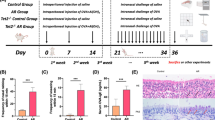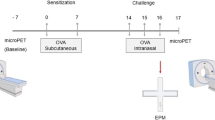Abstract
Atopic dermatitis (AD) and mood disorder comorbidities are typical, but the exact mechanism underlying their interplay has not been clarified. In this study, we aimed to identify the possible mechanisms of anxiety/depressive-like behaviors observed in AD, focusing on microglia. AD was induced by Dermatophagoides farinae body extract (Dfb) in NC/Nga mice and anxiety/depressive-like behaviors were analyzed by behavioral assessments such as open field test (OFT), tail suspension test (TST), sucrose preference test (SPT), and social interaction. As clinical symptoms of AD induced, anxiety/depressive-like behaviors were increased in the OFT and TST and serum glucocorticoid was elevated. AD mice showed an increased mRNA expression of interleukin-4 (IL-4) in lymph nodes but decreased arginase 1 (Arg1) mRNA expression without a change of IL-4 in the hippocampus. In addition, AD mice showed microglia with a shortened branch of de-ramified form and astrocytes with longer processes and decreased branching in the hippocampus, especially in the dentate gyrus (DG). The immunofluorescence study of the DG confirmed that Arg1 reduction was associated with microglia, but not astrocytes. Furthermore, glucocorticoid receptor reduction, increased 5-HT1AR, reduced phosphorylated cAMP response element-binding protein (pCREB), and brain-derived neurotrophic factor (BDNF) expression were identified in the hippocampus of AD mice. Notably, an immunofluorescence study confirmed that pCREB was decreased in the DG of AD mice. Collectively, our data suggest that the reduced Arg1 positive microglia might contribute to anxiety/depressive-like behaviors via pCREB/BDNF reduction in AD.






Similar content being viewed by others
References
Adachi M, Barrot M, Autry AE, Theobald D, Monteggia LM (2008) Selective loss of brain-derived neurotrophic factor in the dentate gyrus attenuates antidepressant efficacy. Biol Psychiatry 63:642–649. https://doi.org/10.1016/j.biopsych.2007.09.019
Aioi A, Tonogaito H, Suto H, Hamada K, Ra CR, Ogawa H, Maibach H, Matsuda H (2001) Impairment of skin barrier function in NC/Nga Tnd mice as a possible model for atopic dermatitis. Br J Dermatol 144:12–18. https://doi.org/10.1046/j.1365-2133.2001.03946.x
Anisman H, Merali Z (2002) Cytokines, stress, and depressive illness. Brain Behav Immun 16:513–524. https://doi.org/10.1016/s0889-1591(02)00009-0
Bathina S, Das UN (2015) Brain-derived neurotrophic factor and its clinical implications. Arch Med Sci 11:1164–1178. https://doi.org/10.5114/aoms.2015.56342
Birdi G, Cooke R, Knibb RC (2020) Impact of atopic dermatitis on quality of life in adults: a systematic review and meta-analysis. Int J Dermatol 59:e75–e91. https://doi.org/10.1111/ijd.14763
Bushong EA, Martone ME, Jones YZ, Ellisman MH (2002) Protoplasmic astrocytes in CA1 stratum radiatum occupy separate anatomical domains. J Neurosci 22:183–192
Chalmers DT, Kwak SP, Mansour A, Akil H, Watson SJ (1993) Corticosteroids regulate brain hippocampal 5-HT1A receptor mRNA expression. J Neurosci 13:914–923
Chen B, Dowlatshahi D, Macqueen GM, Wang JF, Young LT (2001) Increased hippocampal BDNF immunoreactivity in subjects treated with antidepressant medication. Biol Psychiatry 50:260–265. https://doi.org/10.1016/s0006-3223(01)01083-6
Cheng CM, Hsu JW, Huang KL, Bai YM, Su TP, Li CT, Yang AC, Chang WH, Chen TJ, Tsai SJ, Chen MH (2015) Risk of developing major depressive disorder and anxiety disorders among adolescents and adults with atopic dermatitis: a nationwide longitudinal study. J Affect Disord 178:60–65. https://doi.org/10.1016/j.jad.2015.02.025
Cherry JD, Olschowka JA, O’banion MK, (2015) Arginase 1+ microglia reduce Abeta plaque deposition during IL-1beta-dependent neuroinflammation. J Neuroinflamm 12:203. https://doi.org/10.1186/s12974-015-0411-8
Chiricozzi A, Maurelli M, Peris K, Girolomoni G (2020) Targeting IL-4 for the treatment of atopic dermatitis. Immunotargets Ther 9:151–156. https://doi.org/10.2147/ITT.S260370
Deczkowska A, Amit I, Schwartz M (2018) Microglial immune checkpoint mechanisms. Nat Neurosci 21:779–786. https://doi.org/10.1038/s41593-018-0145-x
Drucker AM, Ellis AG, Bohdanowicz M, Mashayekhi S, Yiu ZZN, Rochwerg B, Di Giorgio S, Arents BWM, Burton T, Spuls PI, Kuster D, Siegels D, Schmitt J, Flohr C (2020) Systemic immunomodulatory treatments for patients with atopic dermatitis: a systematic review and network meta-analysis. JAMA Dermatol 156:659–667. https://doi.org/10.1001/jamadermatol.2020.0796
Dwivedi Y, Rizavi HS, Conley RR, Roberts RC, Tamminga CA, Pandey GN (2003) Altered gene expression of brain-derived neurotrophic factor and receptor tyrosine kinase B in postmortem brain of suicide subjects. Arch Gen Psychiatry 60:804–815. https://doi.org/10.1001/archpsyc.60.8.804
Dzik JM (2014) Evolutionary roots of arginase expression and regulation. Front Immunol 5:544. https://doi.org/10.3389/fimmu.2014.00544
Gupta MA, Gupta AK (1998) Depression and suicidal ideation in dermatology patients with acne, alopecia areata, atopic dermatitis and psoriasis. Br J Dermatol 139:846–850. https://doi.org/10.1046/j.1365-2133.1998.02511.x
Halling AS, Loft N, Silverberg JI, Guttman-Yassky E, Thyssen JP (2021) Real-world evidence of dupilumab efficacy and risk of adverse events: a systematic review and meta-analysis. J Am Acad Dermatol 84:139–147. https://doi.org/10.1016/j.jaad.2020.08.051
Han A, Sung YB, Chung SY, Kwon MS (2014) Possible additional antidepressant-like mechanism of sodium butyrate: targeting the hippocampus. Neuropharmacology 81:292–302. https://doi.org/10.1016/j.neuropharm.2014.02.017
Han A, Yeo H, Park MJ, Kim SH, Choi HJ, Hong CW, Kwon MS (2015) IL-4/10 prevents stress vulnerability following imipramine discontinuation. J Neuroinflamm 12:197. https://doi.org/10.1186/s12974-015-0416-3
Hasni Ebou M, Singh-Estivalet A, Launay JM, Callebert J, Tronche F, Ferre P, Gautier JF, Guillemain G, Breant B, Blondeau B, Riveline JP (2016) Glucocorticoids inhibit basal and hormone-induced serotonin synthesis in pancreatic beta cells. PLoS ONE 11:e0149343. https://doi.org/10.1371/journal.pone.0149343
Kim SJ, Lee H, Lee G, Oh SJ, Shin MK, Shim I, Bae H (2012) CD4+CD25+ regulatory T cell depletion modulates anxiety and depression-like behaviors in mice. PLoS ONE 7:e42054. https://doi.org/10.1371/journal.pone.0042054
Kolodziejczak M, Bechade C, Gervasi N, Irinopoulou T, Banas SM, Cordier C, Rebsam A, Roumier A, Maroteaux L (2015) Serotonin modulates developmental microglia via 5-HT2B receptors: potential implication during synaptic refinement of retinogeniculate projections. ACS Chem Neurosci 6:1219–1230. https://doi.org/10.1021/cn5003489
Krabbe G, Matyash V, Pannasch U, Mamer L, Boddeke HW, Kettenmann H (2012) Activation of serotonin receptors promotes microglial injury-induced motility but attenuates phagocytic activity. Brain Behav Immun 26:419–428. https://doi.org/10.1016/j.bbi.2011.12.002
Kulesskaya N, Voikar V (2014) Assessment of mouse anxiety-like behavior in the light-dark box and open-field arena: role of equipment and procedure. Physiol Behav 133:30–38. https://doi.org/10.1016/j.physbeh.2014.05.006
Lim J, Bang Y, Choi JH, Han A, Kwon MS, Liu KH, Choi HJ (2018) LRRK2 G2019S induces anxiety/depression-like behavior before the onset of motor dysfunction with 5-HT1A receptor upregulation in mice. J Neurosci 38:1611–1621. https://doi.org/10.1523/JNEUROSCI.4051-15.2017
Lin P, Wang C, Xu B, Gao S, Guo J, Zhao X, Huang H, Zhang J, Chen X, Wang Q, Zhou W (2014) The VGF-derived peptide TLQP62 produces antidepressant-like effects in mice via the BDNF/TrkB/CREB signaling pathway. Pharmacol Biochem Behav 120:140–148. https://doi.org/10.1016/j.pbb.2014.03.003
Malberg JE, Eisch AJ, Nestler EJ, Duman RS (2000) Chronic antidepressant treatment increases neurogenesis in adult rat hippocampus. J Neurosci 20:9104–9110
Michell-Robinson MA, Touil H, Healy LM, Owen DR, Durafourt BA, Bar-Or A, Antel JP, Moore CS (2015) Roles of microglia in brain development, tissue maintenance and repair. Brain 138:1138–1159. https://doi.org/10.1093/brain/awv066
Miller AH, Maletic V, Raison CL (2009) Inflammation and its discontents: the role of cytokines in the pathophysiology of major depression. Biol Psychiatry 65:732–741. https://doi.org/10.1016/j.biopsych.2008.11.029
Mondelli V, Vernon AC, Turkheimer F, Dazzan P, Pariante CM (2017) Brain microglia in psychiatric disorders. Lancet Psychiatry 4:563–572. https://doi.org/10.1016/S2215-0366(17)30101-3
Morren MA, Przybilla B, Bamelis M, Heykants B, Reynaers A, Degreef H (1994) Atopic dermatitis: triggering factors. J Am Acad Dermatol 31:467–473. https://doi.org/10.1016/s0190-9622(94)70213-6
Morrison HW, Filosa JA (2013) A quantitative spatiotemporal analysis of microglia morphology during ischemic stroke and reperfusion. J Neuroinflamm 10:4. https://doi.org/10.1186/1742-2094-10-4
Muller N, Schwarz MJ (2007) The immune-mediated alteration of serotonin and glutamate: towards an integrated view of depression. Mol Psychiatry 12:988–1000. https://doi.org/10.1038/sj.mp.4002006
Neumaier JF, Sexton TJ, Hamblin MW, Beck SG (2000) Corticosteroids regulate 5-HT(1A) but not 5-HT(1B) receptor mRNA in rat hippocampus. Brain Res Mol Brain Res 82:65–73. https://doi.org/10.1016/s0169-328x(00)00181-9
Oberheim NA, Takano T, Han X, He W, Lin JH, Wang F, Xu Q, Wyatt JD, Pilcher W, Ojemann JG, Ransom BR, Goldman SA, Nedergaard M (2009) Uniquely hominid features of adult human astrocytes. J Neurosci 29:3276–3287. https://doi.org/10.1523/JNEUROSCI.4707-08.2009
Park HS, Park MJ, Kwon MS (2016) Central nervous system-peripheral immune system dialogue in neurological disorders: possible application of neuroimmunology in urology. Int Neurourol J 20:S8-14. https://doi.org/10.5213/inj.1632614.307
Park MJ, Park HS, You MJ, Yoo J, Kim SH, Kwon MS (2019) Dexamethasone induces a specific form of ramified dysfunctional microglia. Mol Neurobiol 56:1421–1436. https://doi.org/10.1007/s12035-018-1156-z
Park HS, You MJ, Yang B, Jang KB, Yoo J, Choi HJ, Lee SH, Bang M, Kwon MS (2020) Chronically infused angiotensin II induces depressive-like behavior via microglia activation. Sci Rep 10:22082. https://doi.org/10.1038/s41598-020-79096-2
Quirie A, Demougeot C, Bertrand N, Mossiat C, Garnier P, Marie C, Prigent-Tessier A (2013) Effect of stroke on arginase expression and localization in the rat brain. Eur J Neurosci 37:1193–1202. https://doi.org/10.1111/ejn.12111
Ransohoff RM (2016) A polarizing question: do M1 and M2 microglia exist? Nat Neurosci 19:987–991. https://doi.org/10.1038/nn.4338
Rasmusson AM, Shi L, Duman R (2002) Downregulation of BDNF mRNA in the hippocampal dentate gyrus after re-exposure to cues previously associated with footshock. Neuropsychopharmacology 27:133–142. https://doi.org/10.1016/S0893-133X(02)00286-5
Siuciak JA, Lewis DR, Wiegand SJ, Lindsay RM (1997) Antidepressant-like effect of brain-derived neurotrophic factor (BDNF). Pharmacol Biochem Behav 56:131–137. https://doi.org/10.1016/S0091-3057(96)00169-4
Slotkin TA, Mccook EC, Ritchie JC, Seidler FJ (1996) Do glucocorticoids contribute to the abnormalities in serotonin transporter expression and function seen in depression? An animal model. Biol Psychiatry 40:576–584. https://doi.org/10.1016/0006-3223(95)00469-6
Sroka-Tomaszewska J, Trzeciak M (2021) Molecular mechanisms of atopic dermatitis pathogenesis. Int J Mol Sci. https://doi.org/10.3390/ijms22084130
Steru L, Chermat R, Thierry B, Simon P (1985) The tail suspension test: a new method for screening antidepressants in mice. Psychopharmacology 85:367–370. https://doi.org/10.1007/BF00428203
Suto H, Matsuda H, Mitsuishi K, Hira K, Uchida T, Unno T, Ogawa H, Ra C (1999) NC/Nga mice: a mouse model for atopic dermatitis. Int Arch Allergy Immunol 120(Suppl 1):70–75. https://doi.org/10.1159/000053599
Tan YL, Yuan Y, Tian L (2020) Microglial regional heterogeneity and its role in the brain. Mol Psychiatry 25:351–367. https://doi.org/10.1038/s41380-019-0609-8
Thyssen JP, Hamann CR, Linneberg A, Dantoft TM, Skov L, Gislason GH, Wu JJ, Egeberg A (2018) Atopic dermatitis is associated with anxiety, depression, and suicidal ideation, but not with psychiatric hospitalization or suicide. Allergy 73:214–220. https://doi.org/10.1111/all.13231
Turkin A, Tuchina O, Klempin F (2021) Microglia function on precursor cells in the adult hippocampus and their responsiveness to serotonin signaling. Front Cell Dev Biol 9:665739. https://doi.org/10.3389/fcell.2021.665739
Wachholz S, Knorr A, Mengert L, Plumper J, Sommer R, Juckel G, Friebe A (2017) Interleukin-4 is a participant in the regulation of depressive-like behavior. Behav Brain Res 326:165–172. https://doi.org/10.1016/j.bbr.2017.03.020
Xia Y, Zhang Z, Lin W, Yan J, Zhu C, Yin D, He S, Su Y, Xu N, Caldwell RW, Yao L, Chen Y (2020) Modulating microglia activation prevents maternal immune activation induced schizophrenia-relevant behavior phenotypes via arginase 1 in the dentate gyrus. Neuropsychopharmacology 45:1896–1908. https://doi.org/10.1038/s41386-020-0743-7
Yamamoto M, Haruna T, Yasui K, Takahashi H, Iduhara M, Takaki S, Deguchi M, Arimura A (2007) A novel atopic dermatitis model induced by topical application with dermatophagoides farinae extract in NC/Nga mice. Allergol Int 56:139–148. https://doi.org/10.2332/allergolint.O-06-458
Yeom M, Ahn S, Oh JY, Kim SY, Lee H, Hahm DH, Park HJ (2020) Atopic dermatitis induces anxiety- and depressive-like behaviors with concomitant neuronal adaptations in brain reward circuits in mice. Prog Neuropsychopharmacol Biol Psychiatry 98:109818. https://doi.org/10.1016/j.pnpbp.2019.109818
You MJ, Bang M, Park HS, Yang B, Jang KB, Yoo J, Hwang DY, Kim M, Kim B, Lee SH, Kwon MS (2020) Human umbilical cord-derived mesenchymal stem cells alleviate schizophrenia-relevant behaviors in amphetamine-sensitized mice by inhibiting neuroinflammation. Transl Psychiatry 10:123. https://doi.org/10.1038/s41398-020-0802-1
Young K, Morrison H (2018) Quantifying microglia morphology from photomicrographs of immunohistochemistry prepared tissue using ImageJ. J vis Exp. https://doi.org/10.3791/57648
Zhang J, Rong P, Zhang L, He H, Zhou T, Fan Y, Mo L, Zhao Q, Han Y, Li S, Wang Y, Yan W, Chen H, You Z (2021) IL4-driven microglia modulate stress resilience through BDNF-dependent neurogenesis. Sci Adv. https://doi.org/10.1126/sciadv.abb9888
Zhou X, Xiao Q, Xie L, Yang F, Wang L, Tu J (2019) Astrocyte, a promising target for mood disorder interventions. Front Mol Neurosci 12:136. https://doi.org/10.3389/fnmol.2019.00136
Acknowledgements
This work has supported by the National Research Foundation of Korea(NRF) grant funded by the Korea government(MSIT)(No. NRF-2020R1C1C1005293)
Funding
The National Research Foundation of Korea (Grant Number NRF-2020R1C1C1005293).
Author information
Authors and Affiliations
Corresponding authors
Ethics declarations
Conflict of interest
The authors declare that they have no competing interests.
Additional information
Publisher's Note
Springer Nature remains neutral with regard to jurisdictional claims in published maps and institutional affiliations.
Supplementary Information
Below is the link to the electronic supplementary material.
Rights and permissions
About this article
Cite this article
Yang, B., Ryu, JS., Rim, C. et al. Possible role of arginase 1 positive microglia on depressive/anxiety-like behaviors in atopic dermatitis mouse model. Arch. Pharm. Res. 45, 11–28 (2022). https://doi.org/10.1007/s12272-022-01369-3
Received:
Accepted:
Published:
Issue Date:
DOI: https://doi.org/10.1007/s12272-022-01369-3




